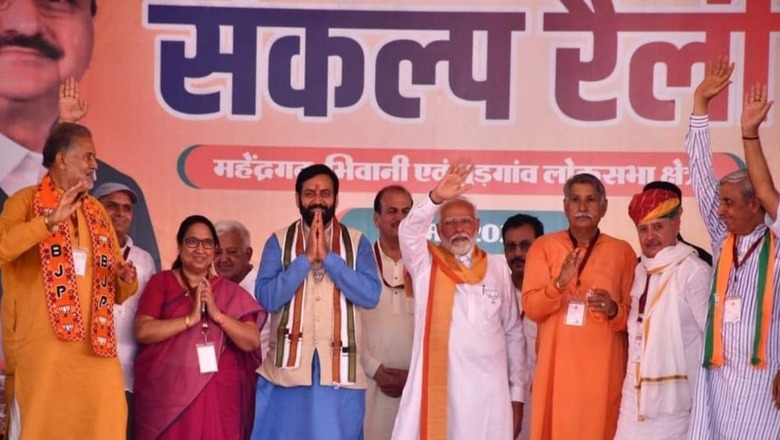
views
The Bharatiya Janata Party’s (BJP) resounding victory in the 2024 Haryana assembly elections has left many stunned. Defying exit poll predictions and silencing whispers of voter discontent, the BJP secured a whopping 50 seats out of 90, solidifying its position as the single-largest party. This triumph enables them to form a majority government, making it their third consecutive term in power.
The BJP’s strategic move to field Nayab Singh Saini as chief minister proved to be a masterstroke. Saini’s leadership led from the front, securing a significant lead in his constituency and contributing significantly to the party’s overall success. The BJP’s ability to overcome anti-incumbency sentiments, a common phenomenon in Indian politics, is a testament to their effective governance and connection with the voters.
In contrast, the Congress party’s internal strife and inability to project a united front worked in the BJP’s favour. Despite initial leads, the Congress ultimately trailed behind, securing 34 seats. Notably, key Congress leaders, including Bhupinder Singh Hooda, performed well in their constituencies, but it wasn’t enough to propel the party to victory.
The BJP’s impressive win in Haryana underscores their enduring popularity and ability to adapt to the changing political landscape. The party’s well-crafted strategy and effective leadership have cemented their position in the state. As the dust settles, it’s clear that the BJP’s victory is a result of their ability to connect with the voters and address their concerns.
The outcome of the Haryana assembly elections serves as a reminder that the BJP remains a formidable force in Indian politics. Their ability to defy expectations and secure decisive victories underscores their organisational strength and strategic prowess. As the BJP looks to build on this momentum, their opponents would do well to take note of the lessons from Haryana.
Welfare Scheme
The welfare schemes implemented by the BJP government played a crucial role in helping the party secure victory in the 2024 Haryana Assembly elections. These programs not only reached the grassroots but also resonated with both rural and urban voters across caste and economic lines.
Key among these schemes is the Pradhan Mantri Kisan Samman Nidhi (PM-Kisan), which provides financial support to small and marginal farmers. Haryana, with its predominantly agrarian economy, saw a significant number of beneficiaries. For farmers grappling with rising input costs and fluctuating crop prices, the steady income from PM-Kisan offered much-needed relief. The BJP successfully positioned itself as a champion of rural welfare, and the financial stability provided by this scheme won over rural voters, including the influential Jat community.
Another vital initiative is the Pradhan Mantri Awas Yojana (PMAY), which aims to provide affordable housing to low-income families. The successful implementation of this programme, particularly in urban and semi-urban areas, gave the BJP a strong foothold among lower-income groups. These beneficiaries, who saw direct improvements in their living conditions, were a key electoral bloc for the BJP in regions like Faridabad and Gurugram. Furthermore, schemes like Ayushman Bharat and various social security programmes provided accessible healthcare and financial protection to vulnerable communities. These initiatives not only uplifted marginalised groups but also showcased the BJP’s focus on inclusive growth.
By effectively communicating the benefits of these welfare schemes and ensuring their reach across diverse voter bases, the BJP built a strong narrative of development and support, which was instrumental in securing its third consecutive term in Haryana.
Fragmented Opposition
The fragmentation of opposition votes in the 2024 Haryana Assembly elections proved to be a significant factor in the BJP’s victory. The anti-BJP vote, which had the potential to challenge the incumbent party, was dispersed among multiple political players, severely limiting the Congress’s ability to consolidate a unified Opposition. The Indian National Lok Dal (INLD) and the Jannayak Janata Party (JJP), both historically rooted in the state’s political landscape, continued to attract a significant portion of voters, particularly in rural and Jat-dominated regions. Despite their decline over the years, these parties retained enough influence to split the vote in constituencies where the Congress could have otherwise posed a formidable challenge.
For example, in several constituencies in central and western Haryana, where Jat politics is dominant, voters split between these regional parties, leaving the Congress unable to build the necessary momentum to challenge the BJP.
The Aam Aadmi Party (AAP), having gained traction in neighbouring Punjab and Delhi, also made inroads in Haryana, particularly in urban constituencies like Gurugram and Faridabad. AAP’s promise of governance reforms and its urban-focused manifesto resonated with sections of the electorate, drawing away crucial votes from the Congress in cities where the BJP was traditionally strong. This siphoning of urban votes further undermined Congress’s chances of presenting a unified alternative to the BJP’s dominance.
In addition to regional parties, independent candidates with strong local following also played a role in splintering the Opposition vote. Many of these candidates, especially in rural and semi-urban constituencies, performed well enough to detract from the Congress’s vote share, leaving it short of victory margins. The lack of a cohesive Opposition alliance magnified these vote splits. Without a coordinated strategy to bring together regional players, the Congress failed to present itself as the sole alternative to the BJP, allowing the ruling party to secure victories in constituencies where the combined Opposition vote could have challenged it. This fragmentation of the anti-BJP vote ultimately cleared the path for BJP’s win.
OBC Vote Consolidation
In the 2024 Haryana Assembly elections, the BJP effectively consolidated support from the Other Backward Classes (OBCs), a key factor in securing its third consecutive term in power. This strategic success can be attributed to several political manoeuvres and policy initiatives that resonated with OBC communities across the state.
A major move was the BJP’s decision to replace long-standing Chief Minister Manohar Lal Khattar with Nayab Singh Saini, a leader from the OBC community. By selecting an OBC leader for the top position, the BJP sent a clear message of inclusivity and empowerment, ensuring that OBC voters felt directly represented in the state’s leadership. This shift helped the party build a broader social coalition, countering the dominance of Jat leaders in Haryana’s political landscape, particularly the Congress’s reliance on Bhupinder Singh Hooda.
Moreover, the BJP’s welfare schemes and development initiatives were crafted to appeal to economically vulnerable groups, including the OBCs. Programmes like PM-Kisan and Ayushman Bharat were seen as directly benefiting rural and semi-urban communities where the OBCs form a significant portion of the population. These schemes helped create a narrative that the BJP was focused on inclusive development, which contrasted with the Opposition’s more Jat-centric approach.
The BJP also strengthened its ties with the OBC communities through the RSS’s groundwork in Haryana’s rural areas. The Sangh Parivar’s outreach helped mobilise support for the BJP by focusing on cultural and social issues that aligned with OBC concerns. The party’s emphasis on caste equality within the Hindu fold, coupled with policies aimed at economic upliftment, resonated strongly with these voters.
The author, a columnist and research scholar, teaches journalism at St. Xavier’s College (autonomous), Kolkata. His handle on X is @sayantan_gh. Views expressed in the above piece are personal and solely that of the author. They do not necessarily reflect News18’s views.




















Comments
0 comment